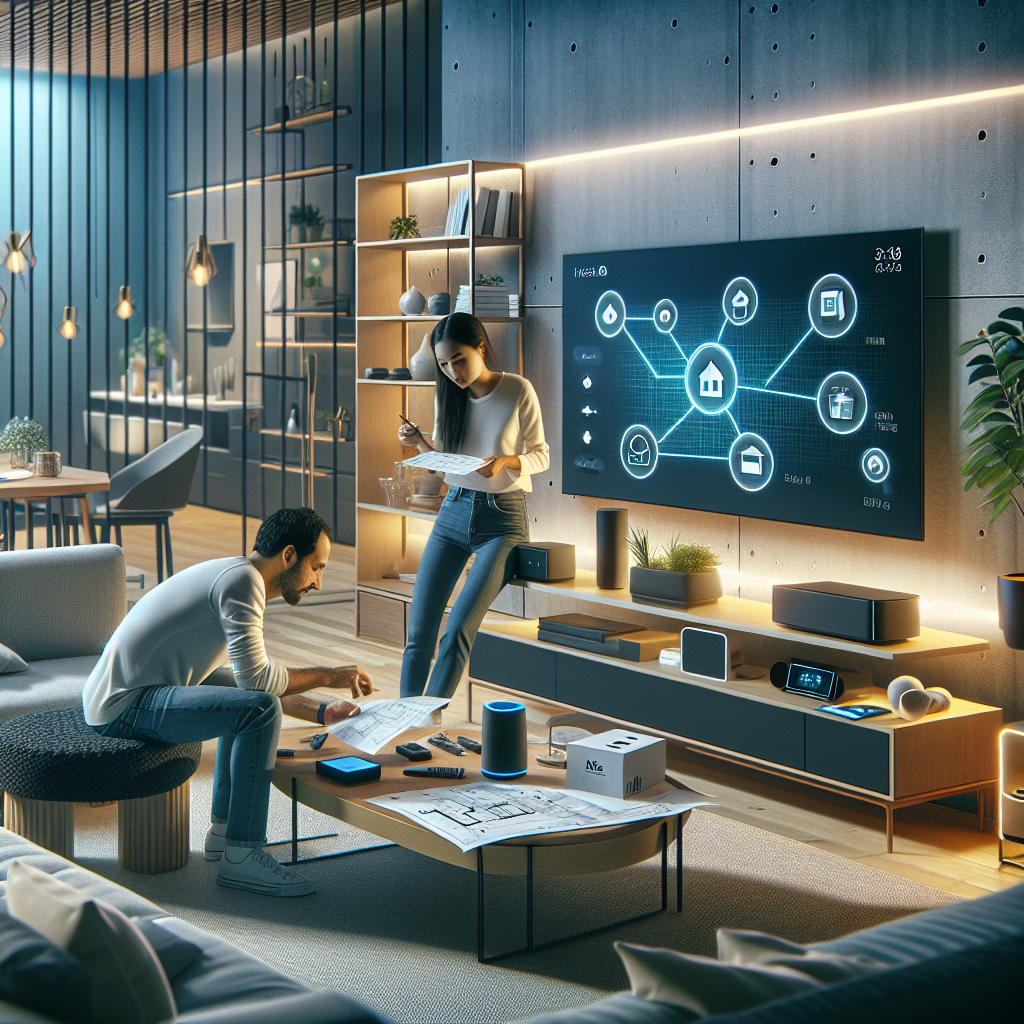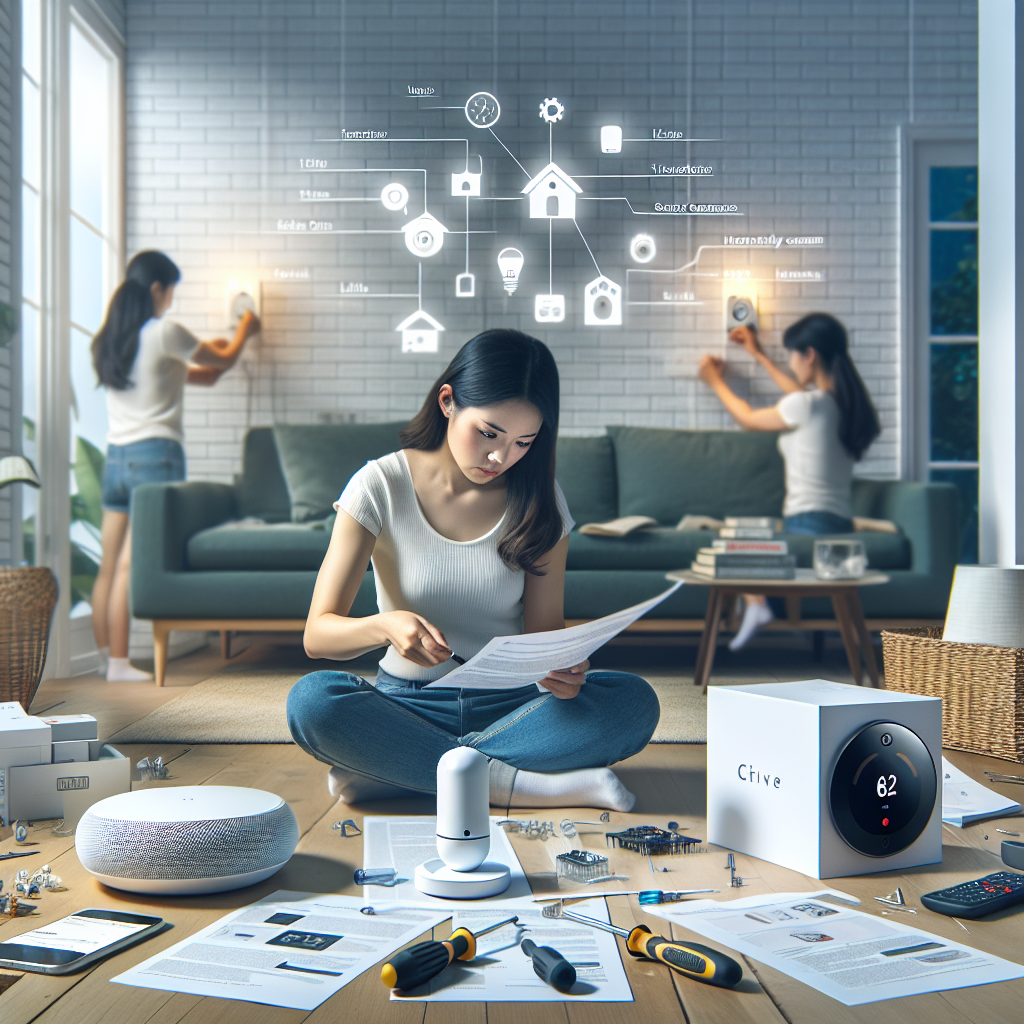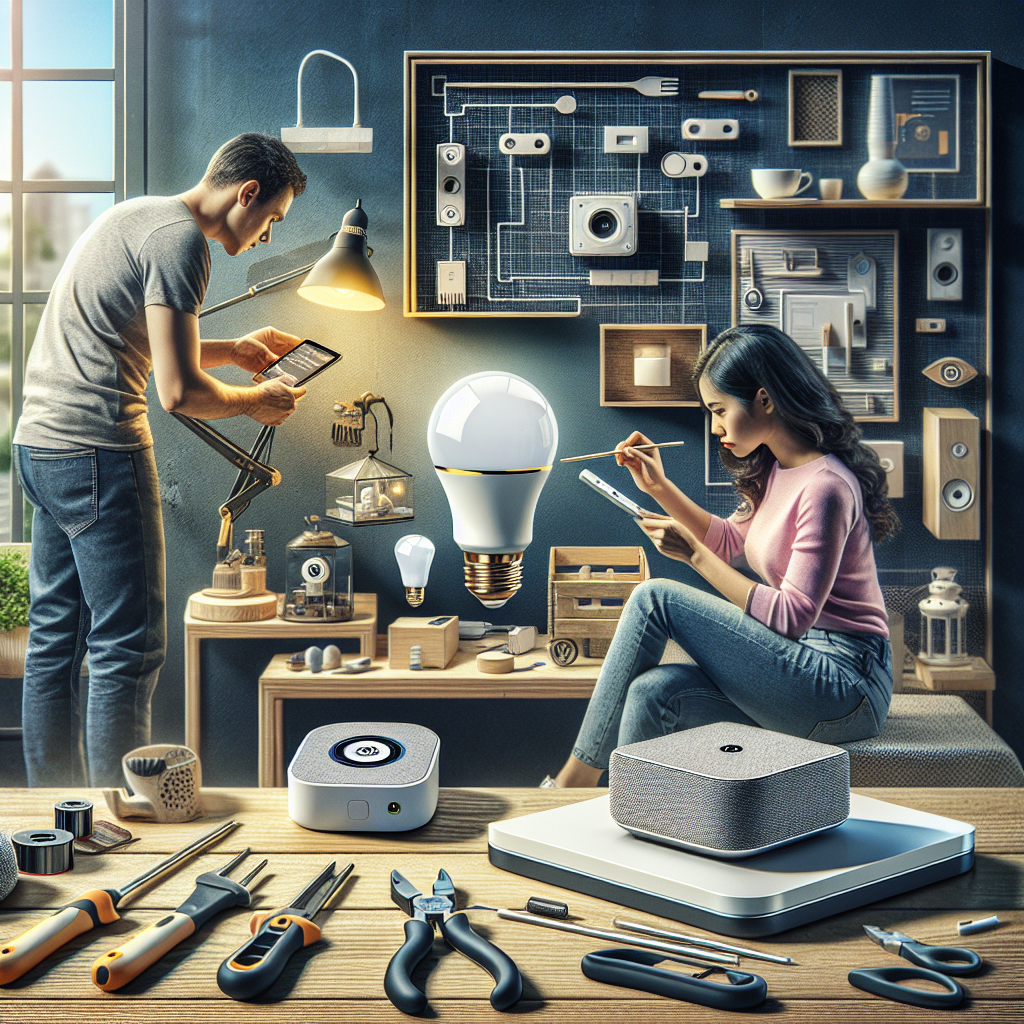Welcome to the ultimate guide on installing smart home devices! In this comprehensive guide, we will walk you through the process of setting up and installing a wide range of smart devices in your home, including smart lights, thermostats, security cameras, doorbells, and more. Whether you’re a tech-savvy enthusiast or a novice looking to upgrade your living space, this guide is your go-to resource for transforming your house into a modern, connected home. Get ready to bring convenience, efficiency, and security to your everyday life with our step-by-step instructions and helpful tips. Let’s get started on creating your smart home oasis!
Understanding Smart Home Devices

Smart home devices refer to electronic gadgets and appliances that can connect, interact, and be controlled remotely through a smartphone or a voice assistant. These devices are designed to make homes more convenient, efficient, and secure.
-
What are Smart Home Devices?
Smart home devices encompass a wide range of products, including smart lights, thermostats, security cameras, door locks, speakers, and even kitchen appliances. They are equipped with sensors, Wi-Fi connectivity, and smart technology to enable users to monitor and manage them from anywhere using a mobile app or voice commands.
-
Benefits of Smart Home Devices
The integration of smart home devices offers numerous benefits to homeowners. These devices enhance convenience by allowing users to automate tasks, such as adjusting the temperature, turning lights on and off, or monitoring their home security remotely. Additionally, smart home devices can help save energy, improve home security, and provide valuable insights into daily routines.
-
Types of Smart Home Devices
There is a wide variety of smart home devices available on the market, each serving a specific purpose. Some popular types include smart thermostats like Nest or Ecobee, smart lighting systems such as Philips Hue, smart security cameras like Ring or Arlo, and smart speakers like Amazon Echo or Google Home. Each type of smart home device offers unique features and functionalities to cater to different needs and preferences.
Preparing for Installation
Before diving into setting up your smart home devices, it is crucial to adequately prepare for the installation process. This preparation phase can help ensure a smooth and successful integration of your devices into your home environment.
- Assessing Your Needs
Begin by identifying the specific needs and requirements you have for your smart home setup. Consider factors such as the size of your home, the number of rooms you want to equip with smart devices, and the functionalities you wish to have. This initial assessment will help you determine the types and quantities of devices you will need to purchase for your smart home system.
- Compatibility Check
Once you have a clear understanding of your needs, it is essential to check the compatibility of the smart devices you plan to install. Ensure that the devices you select are compatible with each other and can be integrated seamlessly into a unified system. Check for compatibility with your existing home infrastructure, such as Wi-Fi network capabilities and smartphone compatibility.
- Setting a Budget
Smart home devices come in a wide range of prices, so it is important to establish a budget before making any purchases. Consider the upfront costs of the devices themselves, as well as any additional costs for installation, maintenance, and potential subscription fees for smart home services. Setting a budget can help you prioritize your needs and make informed decisions when selecting smart devices for your home.
Installation Process
Creating a Smart Home Hub
Selecting the Right Hub:
– Research different smart home hubs to find one that aligns with your specific needs and preferences.
– Consider factors such as compatibility with your devices, ease of use, and available features.
– Popular options include Amazon Echo, Google Home, and Samsung SmartThings.
– Ensure the hub supports the communication protocols of your smart devices, such as Wi-Fi, Zigbee, or Z-Wave.
Connecting Devices to the Hub:
– Follow the manufacturer’s instructions for each device to connect them to the smart home hub.
– Typically, this involves downloading the corresponding app, creating an account, and following the in-app setup process.
– Make sure the devices are within range of the hub and have a stable internet connection for seamless operation.
– Test each device’s connection to the hub to ensure they are properly synced and responsive.
Installing Smart Lights
Choosing the Right Bulbs:
– Determine whether you want smart bulbs that change colors, dim, or adjust brightness levels.
– Consider the bulb’s compatibility with your existing fixtures and whether you need specific fittings.
– LED smart bulbs are energy-efficient and offer various features like remote control and scheduling.
Setting Up Light Controls:
– Install the smart bulbs into your light fixtures following the manufacturer’s guidelines.
– Pair the bulbs with the smart home hub using the designated app for centralized control.
– Create customized lighting schedules, scenes, or automation routines based on your preferences.
– Explore additional features like voice control through virtual assistants for hands-free operation.
Setting Up Smart Locks
Choosing the Right Lock:
– Evaluate different smart lock options based on factors such as security features, compatibility with your door, and connectivity options.
– Look for locks that offer keyless entry, remote access, and integration with your smart home ecosystem.
– Popular smart lock brands include August, Schlage, and Yale.
Installing and Configuring Locks:
– Follow the installation instructions provided by the lock manufacturer carefully to ensure proper setup.
– Configure the lock settings through the corresponding app, creating user codes and setting access permissions.
– Test the lock to verify that it operates smoothly and integrates with your smart home hub for centralized control.
– Consider additional security measures like two-factor authentication or activity alerts for enhanced protection.
Installing Smart Security Cameras
Placement Tips:
– Position cameras strategically to cover key entry points and vulnerable areas of your home.
– Ensure the cameras have a clear line of sight and are protected from tampering or extreme weather conditions.
– Consider factors like motion detection sensitivity, night vision capabilities, and storage options when selecting camera locations.
Connecting Cameras to the Network:
– Connect the security cameras to your home Wi-Fi network following the manufacturer’s instructions.
– Set up cloud storage or local storage options for video recordings based on your preferences and budget.
– Configure camera settings, such as motion alerts, scheduled recording, or live streaming, through the camera’s app.
– Test the camera feed to confirm a stable connection and adjust settings as needed for optimal performance.

Integrating Systems
Integrating smart home devices involves the seamless connection and communication between different components to create a cohesive and efficient system. This process ensures that all devices work together harmoniously to enhance the overall functionality of the smart home. Here are the key steps involved in integrating systems:
- Creating Automation Scenes
Setting up automation scenes allows users to control multiple devices simultaneously with a single command. For example, a “Good Morning” scene can be programmed to turn on the lights, adjust the thermostat, and brew a pot of coffee when activated. This streamlines daily routines and enhances convenience.
- Programming Timers and Triggers
Timers and triggers play a crucial role in automating actions based on specific conditions or schedules. By programming triggers such as motion detection or door sensor activation, users can ensure that devices respond promptly to various events. Timers can be set to turn off lights at a certain time or adjust the temperature throughout the day to optimize energy efficiency.
- Testing Automation Sequences
Before fully integrating systems, it is essential to test automation sequences to identify any potential issues or malfunctions. This step involves running through different scenarios to ensure that all devices respond as intended and that the automation flows smoothly. Testing helps in troubleshooting errors and fine-tuning the system for optimal performance.
- Syncing Devices with a Single App
Syncing all smart home devices with a single app provides centralized control and monitoring capabilities. This unified interface allows users to access and manage all connected devices from one location, simplifying operation and enhancing user experience. Centralized control eliminates the need to switch between multiple apps, making it easier to adjust settings and monitor activity.
- Benefits of Centralized Control
Centralized control offers several advantages, including improved accessibility, streamlined operation, and enhanced security. With all devices accessible through a single app, users can conveniently monitor their home environment, adjust settings on-the-go, and receive notifications or alerts from a centralized platform. This centralized approach enhances the overall efficiency and convenience of managing smart home systems.
- Troubleshooting Connectivity Issues

Connectivity issues can arise when integrating multiple devices within a smart home system. Troubleshooting these problems involves identifying the root cause of connectivity issues, such as signal interference, network configuration errors, or device compatibility issues. By diagnosing and addressing connectivity issues promptly, users can ensure that all devices communicate effectively and operate seamlessly within the integrated system.
Enhancing Home Efficiency
In today’s modern world, homeowners are increasingly turning to smart home devices to enhance the efficiency of their living spaces. By incorporating these innovative technologies, individuals can monitor and manage their energy consumption more effectively while also improving overall sustainability. Two key areas where smart home devices can significantly impact efficiency are energy monitoring and water leak detection.
- Energy Monitoring and Management
Smart home devices offer a range of solutions for energy monitoring and management, empowering homeowners to make informed decisions about their energy usage. By utilizing smart thermostats, individuals can regulate the temperature of their homes more efficiently, optimizing energy consumption and reducing utility costs. These devices can be programmed to adjust temperatures based on occupancy patterns, weather conditions, and personal preferences, ensuring a comfortable living environment while minimizing energy waste.
- Water Leak Detection
In addition to energy efficiency, smart home devices also play a crucial role in detecting and preventing water leaks. By installing smart leak sensors throughout the home, individuals can receive real-time alerts about potential leaks, enabling them to take immediate action to mitigate water damage. These sensors can be placed near appliances, plumbing fixtures, and areas prone to leaks, providing comprehensive coverage and peace of mind for homeowners. By setting up alerts for leak detection, individuals can proactively address issues before they escalate, ultimately safeguarding their homes from water-related disasters.
Troubleshooting and Maintenance
When setting up smart home devices, users may encounter various issues that require troubleshooting and regular maintenance to ensure optimal performance. Here are some key aspects to consider:
-
Common Installation Issues
-
Connectivity Problems
Connectivity problems are commonly faced during installation, often due to Wi-Fi signal issues or incompatible network settings. To address this, users should ensure that the device is within range of a strong Wi-Fi signal and that the network settings are compatible with the device specifications. Rebooting the router and resetting the device’s network settings can also help resolve connectivity problems.
-
Device Pairing Failures
Device pairing failures can occur when the device is not properly set up or when there is interference from other devices. To troubleshoot pairing issues, users should follow the manufacturer's instructions carefully, ensure that the device is in pairing mode, and minimize interference from other electronics. Resetting the device and reattempting the pairing process can often resolve this issue. -
Regular Maintenance Practices
-
Updating Firmware
Regularly updating the firmware of smart home devices is essential to ensure security, stability, and access to the latest features. Users should check for firmware updates regularly through the device’s companion app or the manufacturer’s website. Following the update instructions provided by the manufacturer can help keep the device running smoothly.
-
Checking Battery Levels
Checking the battery levels of smart home devices is crucial for uninterrupted operation. Low battery levels can lead to device malfunctions or disconnections. Users should monitor battery levels through the device's app or indicator lights and replace batteries as needed to maintain optimal performance. Regularly checking and replacing batteries can prevent unexpected issues with smart home devices.
FAQs Smart Home Devices Installation Guide
What smart home devices do I need to install in my home?
The smart home devices you need will depend on your specific needs and wants. Common smart home devices include smart thermostats, smart light bulbs, smart security cameras, smart door locks, smart outlets, and smart speakers. You can start by identifying areas in your home where you want to automate and enhance control and then choose the appropriate devices for those areas.
How do I install smart home devices in my home?
The installation process for smart home devices will vary depending on the type of device and manufacturer. Generally, the process involves setting up the device through a mobile app, connecting it to your home Wi-Fi network, and following the manufacturer’s instructions for installation and setup. Make sure to read the user manual carefully and reach out to customer support if you encounter any issues.
Do I need any special skills or tools to install smart home devices?
Most smart home devices are designed to be user-friendly and easy to install, so you generally won’t need any special skills or tools. However, it’s always a good idea to read the installation instructions carefully and make sure you have a stable internet connection and a compatible smartphone or tablet for setup. If you’re not comfortable with technology, you may want to enlist the help of a friend or consider professional home security installation with a provider like Vivint.
How can I troubleshoot common issues during the installation of smart home devices?
If you encounter any issues during the installation of your smart home devices, the first step is to check the manufacturer’s website or customer support for troubleshooting guides. Common issues include Wi-Fi connectivity problems, device pairing issues, and software updates. You can also try resetting the device and your Wi-Fi network, as well as ensuring that your devices are within range of each other. If all else fails, reach out to customer support for assistance.